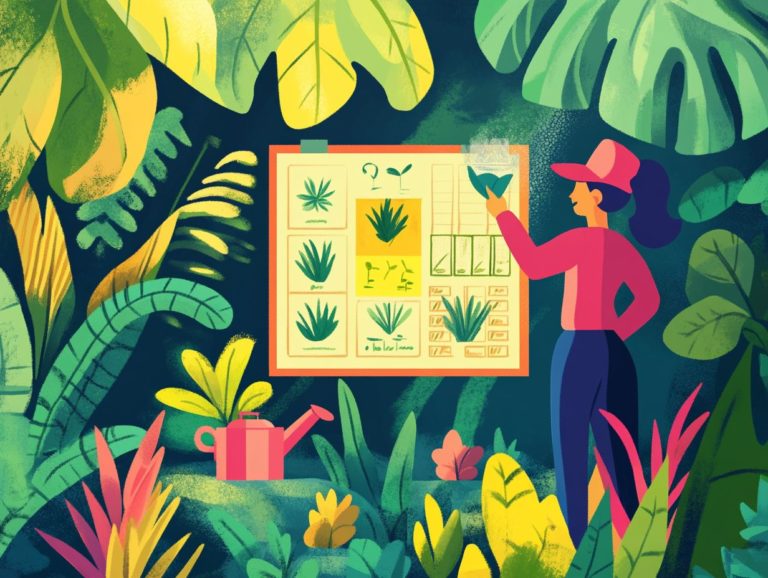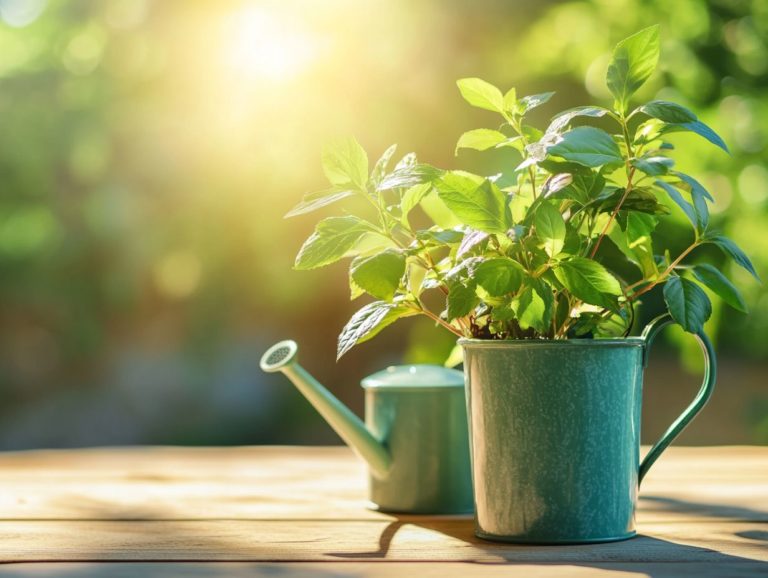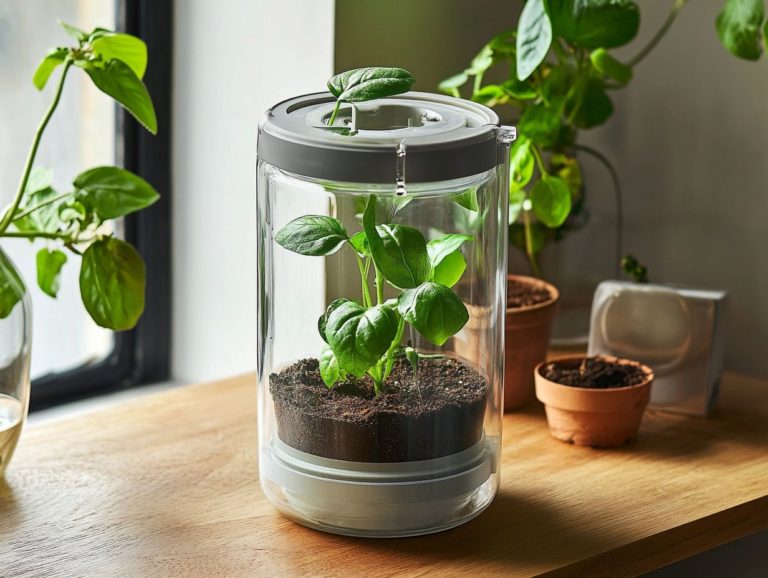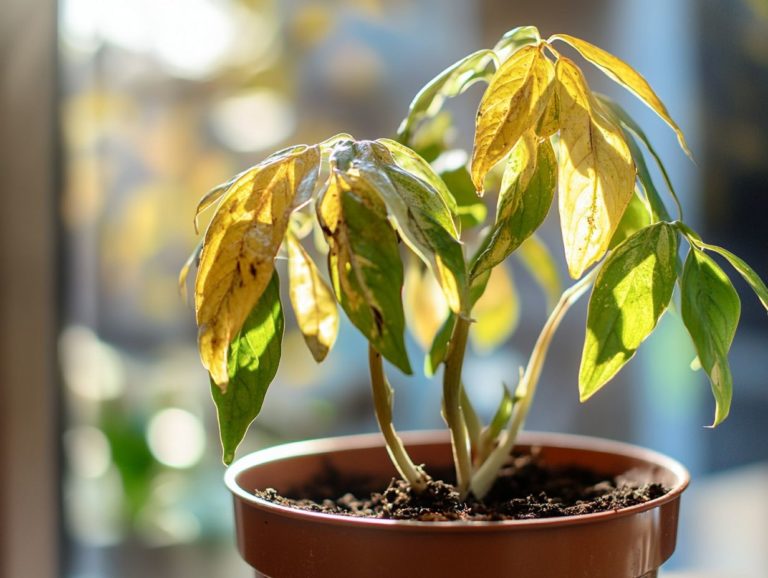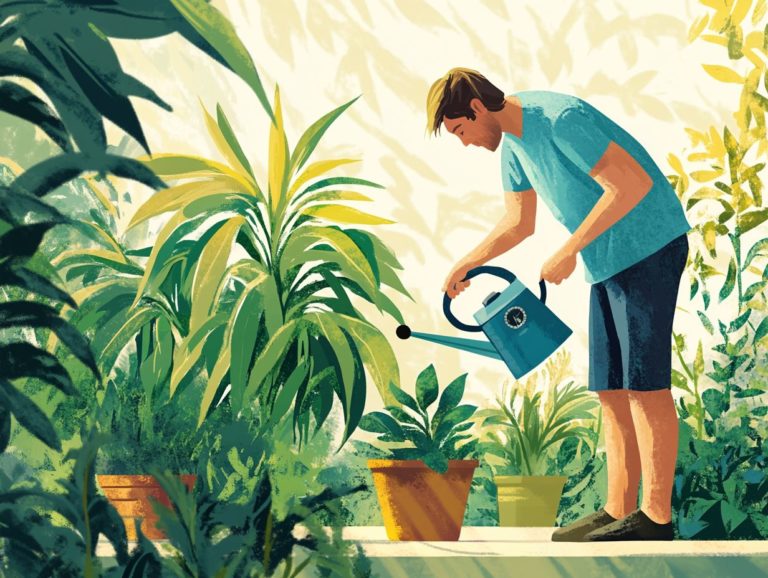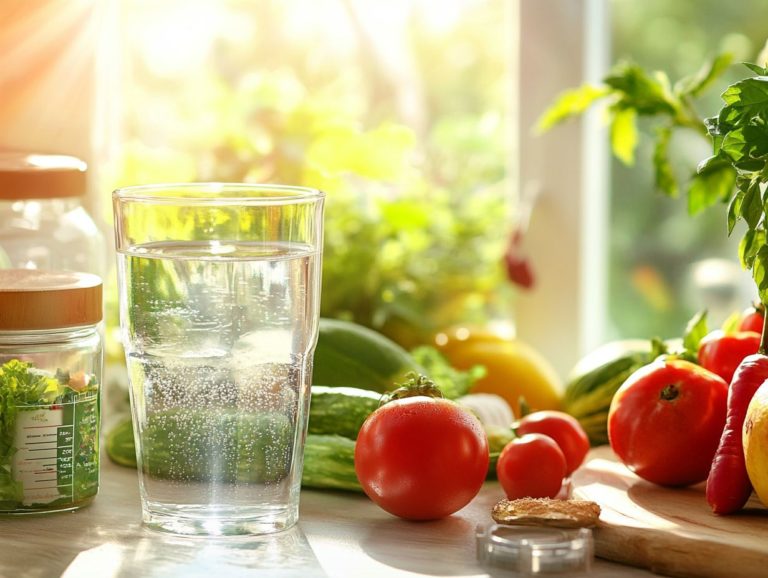Watering Strategies for Large Indoor Plants
Caring for large indoor plants, such as Ficus benjamina, Peace Lilies, and Snake Plants, can be a truly rewarding experience! However, it comes with challenges, particularly when it comes to watering.
Know what affects your large indoor plants water needs! This is key to keeping them healthy and vibrant. Factors like plant size, type, light conditions, humidity, and temperature influence how often you should water.
This article delves into vital aspects like recognizing the signs of under or over-watering, employing effective watering techniques, and selecting the right tools to establish a consistent watering routine.
With the right knowledge and practices at your disposal, you can ensure your indoor plants flourish in all their lush glory.
Contents
- Key Takeaways:
- Factors Affecting Watering Needs of Large Indoor Plants
- Signs of Under or Over Watering
- Watering Techniques for Large Indoor Plants
- Choosing the Right Watering Tools
- Creating a Watering Schedule
- Frequently Asked Questions
- What are some watering strategies for large indoor plants?
- How often should I water my large indoor plants?
- What is the best way to water large indoor plants?
- Can I use a watering can to water my large indoor plants?
- What should I do if my large indoor plant is wilting?
- Is it better to water large indoor plants from the top or bottom?
Key Takeaways:

- Proper watering for large indoor plants depends on their size, type, and environmental conditions such as light and temperature.
- Signs of under-watering, such as wilting leaves and parched soil, or over-watering, like root rot, can be identified and addressed to keep your plants healthy.
- Utilizing best practices and choosing the right watering tools can ensure optimal watering for your large indoor plants. Consistency and efficiency can be achieved through creating a watering schedule.
Factors Affecting Watering Needs of Large Indoor Plants
Understanding the factors that influence the water needs of large indoor plants is essential for maintaining their health and vitality. These considerations can vary significantly depending on the size and type of your plants, along with the light and temperature conditions they re exposed to.
Different species, such as Ficus benjamina, Peace Lilies, and Snake Plants, showcase unique water needs. As a dedicated plant parent, using tools like a moisture meter can help ensure you deliver the perfect amount of water.
This proactive approach helps you avoid the pitfalls of over-watering or under-watering, keeping your plants healthy.
Size and Type of Plant
The size and type of your indoor plants are crucial factors in determining their watering needs. Generally, larger plants require more water than their smaller counterparts.
Beyond size, different species have unique water needs, reflective of their native environments. For example, tropical plants flourish in humid conditions and may require more frequent watering, while cacti, adapted to arid climates, prefer to dry out between waterings.
Pay attention to signs of growth such as curling leaves or dropped stems to know when a plant like Ficus benjamina or Dracaena marginata is thirsty. Understanding these characteristics is vital for nurturing your indoor greenery; ignoring a plant’s individual water preferences could lead to stress and, ultimately, a decline in its vitality.
Light and Temperature Conditions
The light and temperature conditions in which your indoor plants thrive significantly influence their watering needs and overall health.
When light levels are low, your plants typically require less water, as their growth slows down and moisture lingers longer in the soil. In contrast, medium lighting encourages active growth, necessitating regular watering to maintain optimal hydration.
If your plants bask in bright light, be mindful this can lead to increased evaporation, drying out the soil more quickly and demanding more frequent watering. Higher temperatures can intensify moisture loss and raise the humidity around your plants.
To create the best environment, consider using humidity trays or misting during warm spells. Keep a close eye on soil moisture to ensure your plants are properly hydrated.
Start your watering routine today and watch your indoor plants thrive!
Signs of Under or Over Watering
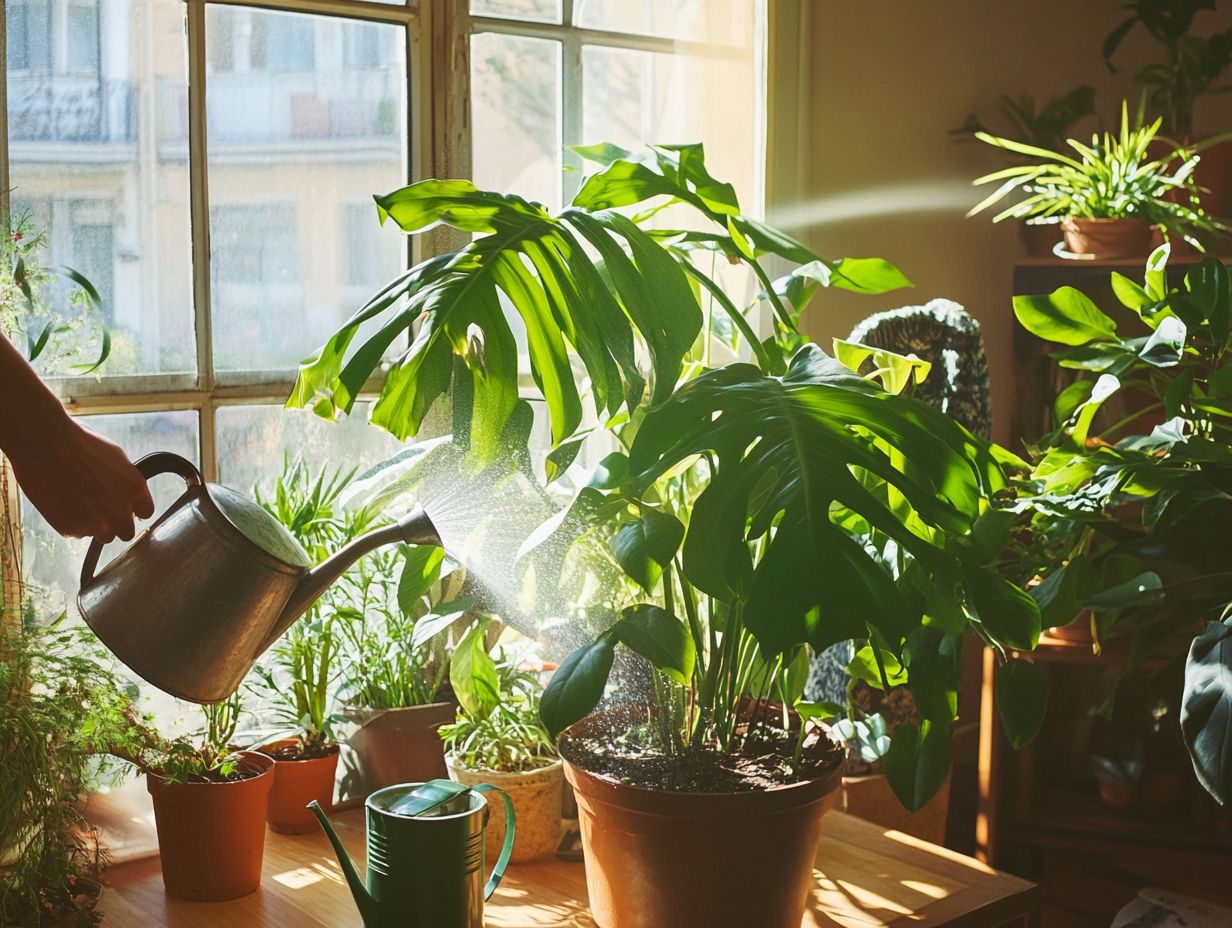
Recognizing the signs of under or overwatering is crucial for keeping your indoor plants healthy. Both situations can cause serious damage or even kill your plants.
Signs of underwatering include wilting leaves and dry soil. Overwatering may lead to root rot and other health problems.
By understanding these symptoms, you can take proactive steps to monitor your plants. This will help prevent any watering mistakes that could harm your cherished houseplants.
Identifying and Addressing Issues
Identifying watering issues in your indoor plants requires careful observation. Understanding their needs will help ensure their longevity.
Look for signs like yellowing leaves, stunted growth, or mushy stems. Using tools like moisture meters can help you measure soil moisture accurately.
Watering apps can track your schedules and remind you when it’s time to water. These tools promote healthier growth and deepen your connection with your indoor plants.
Watering Techniques for Large Indoor Plants
Effective watering techniques are vital for your large indoor plants. Consider using self-watering planters to regulate moisture levels.
Having a consistent watering schedule tailored to each plant is equally important. Remember that drainage holes in pots are essential to prevent overwatering and promote healthier root development.
Best Practices for Optimal Watering
Want your large indoor plants to thrive? Implement these best watering practices!
Use room-temperature water to avoid shocking your plants. Water during spring and summer when your plants are actively growing for better results.
Establish a consistent watering routine to check moisture levels. This helps you avoid the problems of overwatering and underwatering.
Avoid common mistakes like watering leaves instead of soil and neglecting drainage. This will create a thriving environment for your beautiful indoor plants.
Choosing the Right Watering Tools

Selecting the right watering tools is key to caring for your plants. With watering cans and moisture meters, you can deliver the perfect amount of water for each plant.
Using self-watering planters helps maintain consistent moisture. Also, understanding the importance of drainage holes in pots prevents overwatering.
Options for Large Indoor Plants
When choosing watering tools for your large indoor plants, several effective options are available.
Moisture meters are essential for checking soil moisture. Self-watering planters offer convenience by allowing plants to absorb water as needed.
If you prefer a hands-on approach, traditional watering cans let you target the base of each plant while minimizing evaporation. Use these tools to elevate your care routine and help your plants thrive and flourish.
Creating a Watering Schedule
Establishing a well-planned watering schedule is essential for achieving consistency and efficiency in your indoor plant care. A customized plan should consider the specific needs of each plant species, factoring in elements such as humidity, light conditions, and growth cycles.
Observe the hydration levels of each plant closely to fine-tune your watering routine. Make necessary adjustments to enhance their overall health and vitality.
Tips for Consistency and Efficiency
To achieve consistency and efficiency in watering your large indoor plants, specific strategies can significantly enhance your plant care routine.
Consider setting up reminders on your phone or using specialized watering apps to simplify tracking your plants’ needs. Creating a schedule tailored to the specific requirements of each plant species can also be incredibly beneficial, as different types may require varying amounts of water. For detailed guidance, explore watering techniques for different indoor species.
Regularly monitoring your plants allows you to identify when they need extra attention, enabling a personalized care routine. Pay attention to changes in leaf color or soil moisture; these can serve as valuable indicators to refine your watering habits. For more insights, check out the best way to water indoor plants. This ensures that each plant receives the optimal hydration necessary for them to thrive.
Frequently Asked Questions
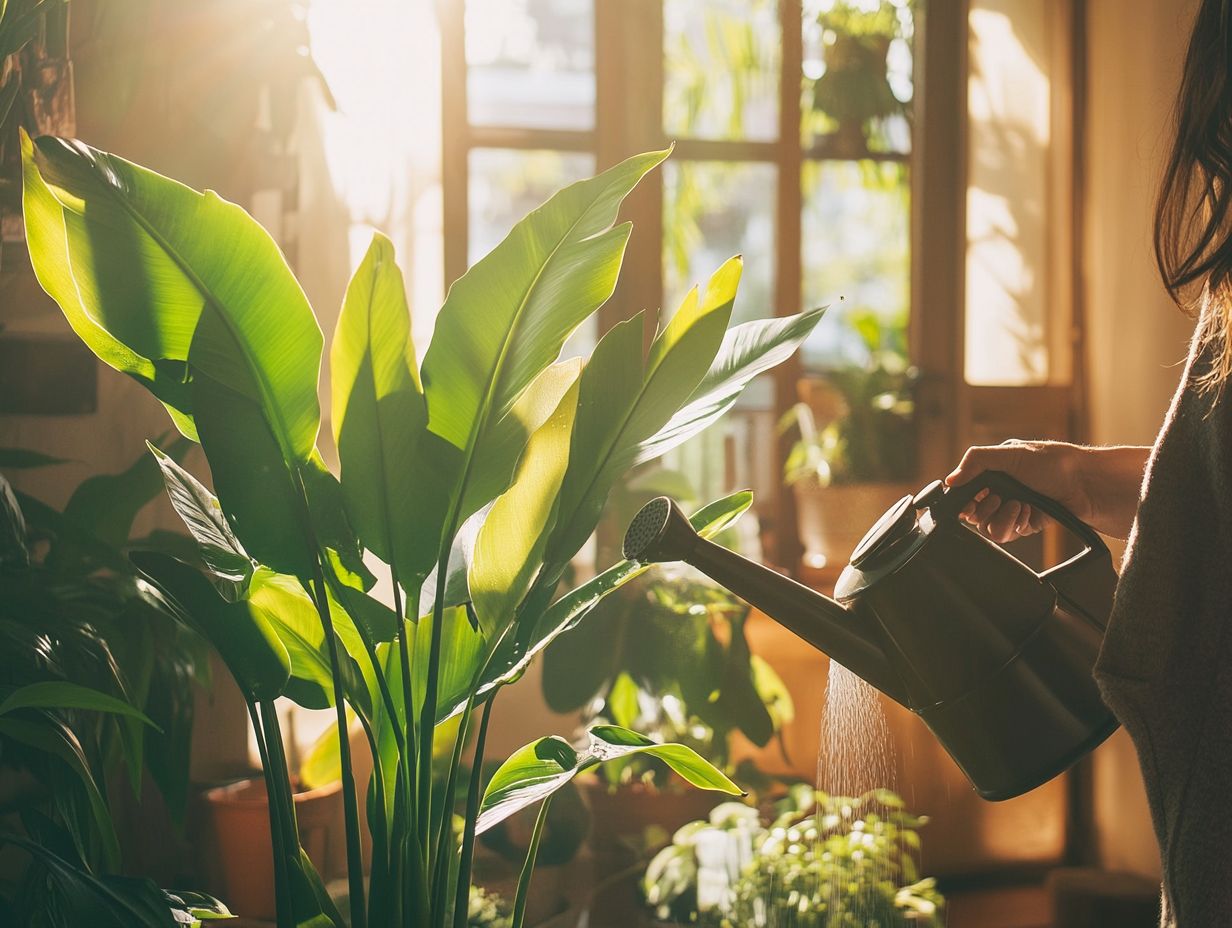
What are some watering strategies for large indoor plants?
Some effective watering strategies for large indoor plants include watering deeply and infrequently, creating a watering schedule based on the plant’s needs, and checking soil moisture before watering.
How often should I water my large indoor plants?
Watering frequency varies by plant type and size. Most large indoor plants thrive on deep watering once a week, but always check the soil first to avoid overwatering.
What is the best way to water large indoor plants?
The best method to water large indoor plants is to water deeply, allowing the water to reach the bottom of the pot and saturate the entire root system. Avoid getting water on the leaves, as this can lead to fungal diseases.
Can I use a watering can to water my large indoor plants?
Yes, a watering can is a great tool for watering large indoor plants. It allows for precise watering and can be filled with room temperature water to avoid shocking the plant’s roots.
What should I do if my large indoor plant is wilting?
If your large indoor plant is wilting, it may indicate underwatering or overwatering. Check the soil moisture and adjust your watering schedule accordingly. It’s also wise to check for pests or diseases that could be causing the wilting.
Is it better to water large indoor plants from the top or bottom?
It is generally recommended to water large indoor plants from the top, allowing the water to soak into the soil and reach the roots. However, some plants may benefit from bottom watering, where the pot is placed in a tray of water and the plant absorbs moisture through the drainage holes in the bottom.
Start your watering schedule today for healthier, happier plants!

